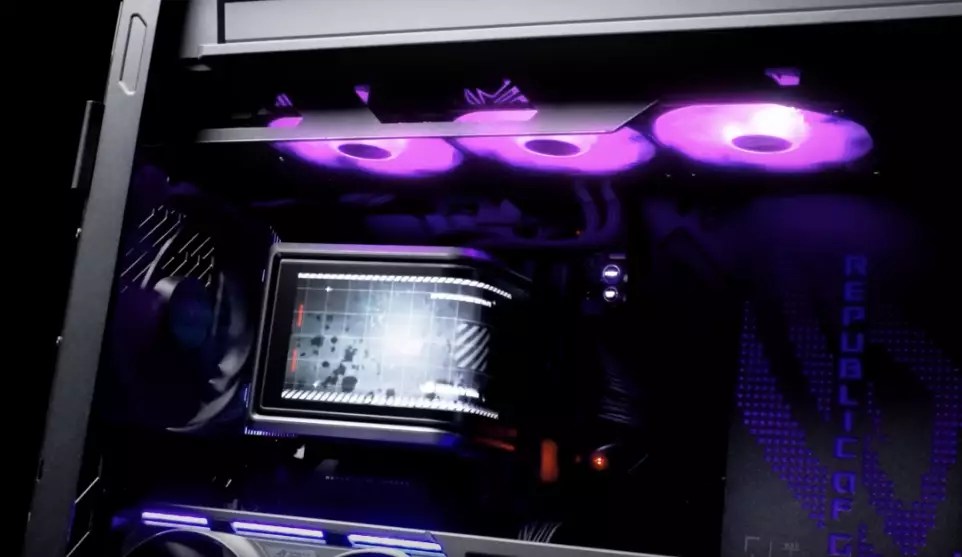The ROG Ryuo IV series from ASUS is not just another entry in the line of high-performance CPU coolers; it is a bold statement that challenges the boundaries of what cooling solutions can achieve. Traditionally, CPU coolers have been utilitarian devices prioritizing efficiency and silence. However, the Ryuo IV breaks free from convention by integrating a visually striking, curved AMOLED display that adds a new layer of interaction and customization. This isn’t merely about keeping processors cool; it’s about transforming the aesthetic and experiential scope of PC building.
What makes this cooler stand out is the incorporation of a movable, curved 6.67-inch AMOLED screen capable of showcasing 3D-effect visuals, system stats, or custom content. This feature pushes the envelope, offering a dynamic visual experience previously unseen in CPU cooling solutions. ASUS’s ingenuity in designing a display that isn’t static but can slide or rotate underscores a commitment to blending form and function seamlessly. This is an undeniably futuristic approach that reflects a growing trend towards personalization and user engagement in PC hardware.
Yet, with innovation comes my criticism. While the concept of a movable, curved display sounds impressive, it risks sacrificing durability and practical usability. Moving parts, especially delicate screens, often introduce vulnerabilities—potential for mechanical failure, dust ingress, or hardware damage over time. Given the hefty price tag, consumers are likely to expect exceptional durability alongside eye-catching design. Also, the implementation of a “3D effect” display, as described, leans more towards visual gimmickry than a genuinely immersive technology like lenticular 3D. In essence, it’s a clever aesthetic trick but does not promise true three-dimensional content.
Performance and Practicality in a Competitive Market
The cooling performance of the ROG Ryuo IV series appears formidable, equipped with ASUS’s robust pump design that ensures high flow rates, lower impedance, and efficient heat transfer. It supports multiple sockets including Intel’s LGA 1851, 1700, and AMD’s AM5 and AM4, ensuring broad compatibility. The inclusion of 400mm tubing improves installation flexibility within larger cases, an essential feature for enthusiasts seeking a clean build.
However, the true draw for most users isn’t just the cooling prowess but the integrated display and its influence on overall usability and aesthetics. The display’s ability to showcase hardware metrics, customized visuals, or split-screen content could revolutionize monitoring. By combining real-time stats with eye-catching effects, ASUS creates an immersive experience that can satisfy both enthusiasts and gamers.
Nonetheless, the practical implications raise questions. The added complexity of a movable screen and high-tech display increases the risk of malfunction over time, especially considering the cooler’s premium price. While the six-year warranty speaks to ASUS’s confidence, it doesn’t negate concerns over mechanical part wear, especially since the display’s lifespan is limited to two years.
In terms of noise levels, the fans with front and side lighting operate at a modest 39.6 dB(A), which remains acceptable for most users. But the real concern is whether the aesthetic features distract from essential cooling performance or contribute meaningfully to the user experience in day-to-day operation.
The Cost of Innovation and Consumer Expectations
Pricing the ROG Ryuo IV at approximately $350 in the UK (around £322) positions it firmly in the high-end segment. While this aligns with its premium features—advanced cooling, customizable display, and aesthetics—the question remains: does the market need such an expensive solution that leans heavily on visual innovation rather than pure efficiency?
The introduction of such a product signifies ASUS’s desire to blend technology, artistry, and personal expression into a single package. For enthusiasts willing to invest heavily in their custom builds, the Ryuo IV offers a unique proposition—one that combines performance with visual flair. But for the average user or even seasoned overclockers, the added cost may not justify the marginal gains in aesthetics or the potential risks associated with movable parts.
Ultimately, the ROG Ryuo IV pushes the boundaries of what is possible in CPU cooling. Its fusion of performance, adaptable visuals, and customization represents a bold step toward a more integrated, user-centric approach. However, it also sets a new benchmark of what consumers might come to expect: not just functional hardware but components that serve as statements of personal style and technological mastery. Whether this trend will shape the future of modular, interactive PC components remains to be seen, but one thing is clear—ASUS has boldly redefined what a CPU cooler can be.


Leave a Reply